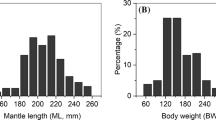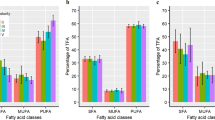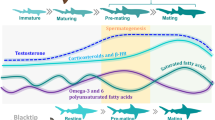Abstract
Most marine invertebrates experience variable environments and for broadcast spawners, fertilisation success increases with greater synchronisation of spawning, so a capital breeding strategy is predicted. However, this prediction should be tested for species with protracted breeding seasons, since it is not clear how reproduction is fuelled over several consecutive months of spawning. The simultaneous hermaphrodite scallop Pecten fumatus was used to test the hypothesis that protracted spawning is supported by both capital and income strategies, depending on the state of energy reserves and food availability at the time of oocyte maturation. The study was carried out in Great Bay, Tasmania, Australia (147.335W, 43.220S) in 2010/2011. The use of glycogen, protein and lipid in the muscle, gonad, and digestive gland was examined, along with the role of atretic eggs as an alternative energy source for oogenesis and maturation. The reproductive stage of an individual was determined using only the ovaries. P. fumatus uses a capital breeding strategy early in the reproductive cycle during winter and spring (August–October) with muscle glycogen and protein and digestive gland lipid providing energy for oogenesis. Given there was no evidence of energy stores being used later in the reproductive cycle in late spring and summer (November–March), when less food was available for direct fuelling of reproduction, it appears that metabolites produced from oocyte lysis may have fuelled oogenesis. Recycling of energy from oocyte resorption must be considered as part of the strategy of energy use to fuel reproduction in marine invertebrates.






Similar content being viewed by others
References
Alonso-Fernández A, Saborido-Rey F (2012) Relationship between energy allocation and reproductive strategy in Trisopterus luscus. J Exp Mar Biol Ecol 416–417:8–16. doi:10.1016/j.jembe.2012.02.001
Arellano-Martinez M, Racotta IS, Ceballos-Vazquez BP, Elorduy-Garay JF (2004) Biochemical composition, reproductive activity and food availability of the lion’s paw scallop Nodipecten subnodosus in the Laguna Ojo de Liebre, Baja California Sur, Mexico. J Shellfish Res 23:15–23
Babcock R, Keesing J (1999) Fertilization biology of the abalone Haliotis laevigata: laboratory and field studies. Can J Fis Aquat Sci 56:1668–1678. doi:10.1139/cjfas-56-9-1668
Babcock R, Mundy C, Whitehead D (1994) Sperm diffusion models and in situ confirmation of long distance fertilization in the free spawning asteroid Acanthaster planci. Biol Bull 186:17–28. doi:10.2307/1542033
Barber B, Blake N (1981) Energy storage and utilization in relation to gametogenesis in Argopecten irradians concentricus (Say). J Exp Mar Biol Ecol 52:121–134
Barber BJ, Blake NJ (2006) Chapter 6 Reproductive physiology. In: Shumway SE, Parsons GJ (eds) Scallops: biology, ecology and aquaculture. Elsevier, Amsterdam, pp 357–416
Barber BJ, Getchell R, Shumway S, Schick D (1988) Reduced fecundity in a deep water population of the giant scallop Placopecten magellanicus in the Gulf of Maine, USA. Mar Ecol Prog Ser 42:207–212. doi:10.3354/meps042207
Bartlett MS (1937) Properties of sufficiency and statistical tests. Proc R Soc Lond Ser A 160:268–282
Beukema JJ, De Bruin W (1979) Calorific values of the soft parts of the tellinid bivalve Macoma balthica (L.) as determined by two methods. J Exp Mar Biol Ecol 37:19–30
Bligh EG, Dyer WJ (1959) A rapid method of total lipid extraction and purification. Can J Biochem Physiol 37:911–917
Bonardelli JC, Himmelman JH (1995) Examination of assumptions critical to body component indices: application to the giant scallop Placopecten magellanicus. Can J Fish Aquat Sci 52:2457–2469. doi:10.1139/f95-836
Bonnet X, Bradshaw D, Shine R (1998) Capital versus income breeding: an ectothermic perspective. Oikos 83:333–342. doi:10.2307/3546846
Brody S (1945) Bioenergetics and growth. Van Nostrand Reinhold, New York
Brokordt KB, Guderley HE (2004) Energetic requirements during gonad maturation and spawning in scallops: sex differences in Chlamys islandica (Muller 1776). J Shellfish Res 23:25–32
Brokordt K, Himmelman J, Guderley H (2000a) Effect of reproduction on escape responses and muscle metabolic capacities in the scallop Chlamys islandica Muller 1776. J Exp Mar Biol Ecol 251:205–225. doi:10.1016/s0022-0981(00)00215-x
Brokordt K, Himmelman J, Nusetti O, Guderley H (2000b) Reproductive investment reduces recuperation from exhaustive escape activity in the tropical scallop Euvola zizac. Mar Biol 137:857–865. doi:10.1007/s002270000415
Burton SA, MacKenzie AL, Davidson TJ, MacNair N (1997) Evaluation of a glucose oxidase peroxidase method for indirect measurement of glycogen content in marine mussels (Mytilus edulis). J Shellfish Res 16:435–439
Cantillanez M, Avendano M, Thouzeau G, Le Pennec M (2005) Reproductive cycle of Argopecten purpuratus (Bivalvia : Pectinidae) in La Rinconada marine reserve (Antofagasta, Chile): Response to environmental effects of El Niño and La Niña. Aquaculture 246:181–195. doi:10.1016/j.aquaculture.2004.12.031
Comely CA (1974) Seasonal variations in flesh weights and biochemical content of scallop Pecten maximus in Clyde Sea area. J Cons Int Explor Mer 35:281–295
Domínguez-Petit R, Saborido-Rey F, Medina I (2010) Changes of proximate composition, energy storage and condition of European hake (Merluccius merluccius, L. 1758) through the spawning season. Fish Res 104:73–82. doi:10.1016/j.fishres.2009.05.016
Dorange G, Le Pennec M (1989) Ultrastructural study of oogenesis and oocytic degeneration in Pecten maximus from the Bay of St. Brieuc. Mar Biol 103:339–348. doi:10.1007/bf00397268
Drent RH, Daan S (1980) The prudent parent–energetic adjustments in avian breeding. Ardea 68:225–252
Duinker A, Nylund A (2002) Seasonal variations in the ovaries of the great scallop (Pecten maximus) from western Norway. J Mar Biol Assoc UK 82:477–482. doi:10.1017/S002531540200574X
Epp J, Bricelj VM, Malouf RE (1988) Seasonal partitioning and utilization of energy reserves in 2 age classes of the bay scallop Argopecten irradians irradians (Lamarck). J Exp Mar Biol Ecol 121:113–136. doi:10.1016/0022-0981(88)90250-x
Fuentes H (1994) Population and biology of the commercial scallop (Pecten fumatus) in Jervis Bay, NSW. Mem Queensl Mus 36:247–259
Geiger SP, Stephenson SP, Arnold WS (2010) Protracted recruitment in the bay scallop Argopecten irradians in a West Florida estuary. J Shellfish Res 29:809–817. doi:10.2983/035.029.0414
Giese AC (1967) Some methods for study of the biochemical constitution of marine invertebrates. Ocean Mar Biol Ann Rev 5:159–186
Gosler AG, Greenwood JD, Perrins C (1995) Predation risk and the cost of being fat. Nature 377:621–623. doi:10.1038/377621a0
Hedenstrom A (1992) Flight performance in relation to fuel load in birds. J Theor Biol 158:535–537. doi:10.1016/s0022-5193(05)80714-3
Huberty CJ, Petoskey MD (2000) Multivariate analysis of variance and covariance. Handbook of applied multivariate statistics and mathematical modeling, New York
Kiernan J (2008) Histological and histochemical methods. Scion Publishing, Oxford
Kohler KE, Gill SM (2006) Coral Point Count with Excel extensions (CPCe): a Visual Basic program for the determination of coral and substrate coverage using random point count methodology. Comput Geosci 32:1259–1269. doi:10.1016/j.cageo.2005.11.009
Le Pennec M, Dorange G, Paulet Y (1991) Trophic sources and pathways to the developing gametes of Pecten maximus (Bivalvia:Pectinidae). J Mar Biol Assoc UK 71:451–463
Levitan DR (1995) The ecology of fertilization in free spawning invertebrates. In: McEdward L (ed) Ecology of marine invertebrate larvae. CRC Press, Boca Raton, pp 123–156
Mason J (1958) The breeding of the scallop Pecten maximus (L.) in Manx waters. J Mar Biol Assoc UK 37:653–671
MATLAB (2006) Matlab version 7.2.0.232. The MathWorks Inc., Natick
McBride RS, Somarakis S, Fitzhugh GR, Albert A, Yaragina NA, Wuenschel MJ, Alonso-Fernández A, Basilone G (2013) Energy acquisition and allocation to egg production in relation to fish reproductive strategies. Fish Fish 16:23–57. doi:10.1111/faf.12043
Mendo T, Moltschaniwskyj N, Lyle JM, Tracey SR, Semmens JM (2014) Role of density in aggregation patterns and synchronization of spawning in the hermaphroditic scallop Pecten fumatus. Mar Biol. doi:10.1007/s00227-014-2551-2
Motavkine PA, Varaksine AA (1989) La reproduction chez les mollusques bivalves: role du systeme nerveux et regulation, France. Rapports scientifiques et Techniques de l’ IFREMER (10)
NASA Ocean Biology (OB) (2013) Sea-viewing Wide Field-of-view Sensor (SeaWiFS) Ocean Color Data, 2013.0 Reprocessing. NASA OB.DAAC, Greenbelt, MD, USA. Maintained by NASA Ocean Biology Distributed Active Archive Center (OB.DAAC), Goddard Space Flight Center, Greenbelt MD. http://oceandata.sci.gsfc.nasa.gov/MODISA/Mapped/Monthly/. Accessed 15 May 2013
Olive PJW, Garwood PR, Bentley MG, Wright N (1981) Reproductive success, relative abundance and population structure of 2 species of Nephtys in an estuarine beach. Mar Biol 63:189–196. doi:10.1007/bf00406827
Olive PJW, Porter JS, Sandeman NJ, Wright NH, Bentley MG (1997) Variable spawning success of Nephtys hombergi (Annelida: Polychaeta) in response to environmental variation a life history homeostasis? J Exp Mar Biol Ecol 215:247–268. doi:10.1016/s0022-0981(97)00047-6
Paulet YM, Lucas A, Gerard A (1988) Reproduction and larval development in two Pecten maximus (L.) populations from Brittany. J Exp Mar Biol Ecol 119:145–156. doi:10.1016/0022-0981(88)90229-8
Pazos AJ, Roman G, Acosta CP, Abad M, Sanchez JL (1996) Stereological studies on the gametogenic cycle of the scallop, Pecten maximus, in suspended culture in Ria de Arousa (Galicia, NW Spain). Aquaculture 142:119–135. doi:10.1016/0044-8486(95)01247-8
Pazos AJ, Román G, Acosta CP, Abad M, Sánchez JL (1997) Seasonal changes in condition and biochemical composition of the scallop Pecten maximus L. from suspended culture in the Ria de Arousa (Galicia, N.W. Spain) in relation to environmental conditions. J Exp Mar Biol Ecol 211:169–193
Quinn G, Keough MJ (2002) Experimental design and data analysis for biologists. Cambridge University Press, Cambridge
R Development Core Team (2010) R Foundation for R: A language and environment for statistical computing, reference index version 2.12.1, Statistical Computing. Vienna, Austria. http://www.R-project.org Accessed 3 Jan 2013
Román G (2002) Reproducción. In: Maeda Martinez A (ed) Los moluscos pectínidos de Iberoamérica: Ciencia y Acuicultura. McGraw-Hill, Mexico, pp 27–51
Román G, Campos MJ, Cano J, Acosta CP, Iglesias P, García O (2002) Reproductive and reserve storage cycles in Aequipecten opercularis (L., 1758) in Galicia, NW Spain. J Shellfish Res 21:577–584
Sause BL, Gwyther D, Hanna PJ, O’Connor NA (1987) Evidence for winter-spring spawning of the scallop Pecten alba (Tate) in Port Phillip Bay, Victoria. Aust J Mar Freshw Res 38:329–337
Shafee MS (1981) Seasonal changes in the biochemical composition and calorific content of the black scallop Chlamys varia (L) from Lanveoc, Bay of Brest. Oceanol Acta 4:331–341
Simon CJ, Jeffs A (2011) The effect of dietary carbohydrates on the growth response, digestive gland glycogen digestive enzyme activities of early spiny lobster juveniles, Jasus edwardsii. Aquacult Nutr 17:613–626. doi:10.1111/j.1365-2095.2011.00861.x
Soudant P, Marty Y, Moal J, Robert R, Quéré C, Le Coz JR, Samain JF (1996) Effect of food fatty acid and sterol quality on Pecten maximus gonad composition and reproduction process. Aquaculture 143:361–378. doi:10.1016/0044-8486(96)01276-8
Stephens PA, Boyd IL, McNamara JM, Houston AI (2009) Capital breeding and income breeding: their meaning, measurement, and worth. Ecol 90:2057–2067. doi:10.1890/08-1369.1
Strand O, Nylund A (1991) The reproductive cycle of the scallop Pecten maximus (Linnaeus, 1758) from two populations in Western Norway, 60˚N and 64˚N. In: Shumway S, Sandifer P (eds) An international compendium of scallop biology and culture. The World Aquaculture Society, Baton Rouge, pp 95–105
Strohmeier T, Duinker A, Lie O (2000) Seasonal variations in chemical composition of the female gonad and storage organs in Pecten maximus (L.) suggesting that somatic and reproductive growth are separated in time. J Shellfish Res 19:741–747
Styan CA, Butler AJ (2003) Asynchronous patterns of reproduction for the sympatric scallops Chlamys bifrons and Chlamys asperrima (Bivalvia:Pectinidae) in South Australia. Mar Freshw Res 54:77–86
Sundet JH, Vahl O (1981) Seasonal changes in dry weight and biochemical composition of the tissues of sexually mature and immature Iceland scallops Chlamys islandica. J Mar Biol Assoc UK 61:1001–1010
Tang SF (1941) The breeding of the scallop (Pecten maximus (L.)) with a note on growth rate. Proc Trans Liverpool Biol Soc 54:9–28
Tuomi J, Hakala T, Haukioja E (1983) Alternative concepts of reproductive effort, costs of reproduction and selection in life history evolution. Am Zool 23:25–34
Welch BL (1951) On the comparison of several mean values—an alternative approach. Biometrika 38:330–336. doi:10.2307/2332579
Winsor L (1994) Tissue processing. In: Woods R, Ellis R (eds) Laboratory histopathology: a complete reference. Churchill Livingstone, New York
Witter MS, Cuthill IC (1993) The ecological costs of avian fat storage. Philos Trans: Biol Sci 340:73–92. doi:10.2307/55686
Wright SP (1992) Adjusted p-values for simultaneous inference. Biometrics 48:1005–1013
Young PC, West GJ, McLoughlin RJ, Martin RB (1999) Reproduction of the commercial scallop, Pecten fumatus, Reeve, 1852 in Bass Strait, Australia. Mar Freshw Res 50:417–425
Acknowledgments
The study was conducted under the Authority of the Department of Primary Industries, Parks, Water and Environment (DPIPWE) permit No. 10028. We thank Julian Harrington, Amelia Fowles, Luis Henriquez, and Jaime McAllister for helping with the collection of samples in the field. Help with laboratory analyses was provided by Cedric Simon, Bryan Choa, Baseer Codabaccus, Daniela Farias, and Mana Inoue. We would like to thank two anonymous reviewers for their valuable comments and suggestions to improve the manuscript. This study was supported by funding to JMS by the Australian Government’s Fisheries Research Development Corporation (Project No. 2008/022); JMS and TM by the Tasmanian Department of Primary Industries, Parks, Water and Environment, Fishwise Community Grant; and TM by an Endeavour International Postgraduate Research Scholarship (EIPRS). We also wish to thank Nick Jones and Lara Marcus for comments and valuable suggestions on early drafts of the manuscript.
Author information
Authors and Affiliations
Corresponding author
Additional information
Responsible Editor: J. Grassle.
Reviewed by undisclosed experts.
Rights and permissions
About this article
Cite this article
Mendo, T., Semmens, J.M., Lyle, J.M. et al. Reproductive strategies and energy sources fuelling reproductive growth in a protracted spawner. Mar Biol 163, 2 (2016). https://doi.org/10.1007/s00227-015-2785-7
Received:
Accepted:
Published:
DOI: https://doi.org/10.1007/s00227-015-2785-7




